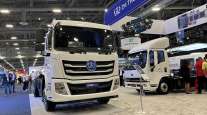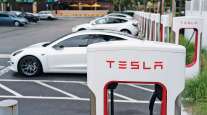Staff Reporter
Grid Planning Must Accommodate Electric Trucks

[Stay on top of transportation news: Get TTNews in your inbox.]
Electrification of longhaul trucking in the U.S., and globally, will require power-grid operators and regulators to change their planning processes and mindset so transmission connections are appropriate for the mass charging of battery-electric trucks, according to a study by analysts at research group BloombergNEF.
Such flexibility would be part of the total cost of ownership for heavy-duty BET models approaching that of their diesel counterparts by 2030, according to the June 8 study, which looks at the prospects for electric vehicles through the end of this decade and beyond.
Proactive central planning can ensure grid connections are properly located and right-sized for the long-term needs of electrified trucking, the analysts said.
So, rather than waiting for a connection request along a key transport route, utilities should be able to take the initiative and open up capacity pre-emptively, the analysts said, adding that regulators should reward rather than punish this type of leadership as it helps accelerate electrification.
This will mean changing decision-making frameworks at regulatory bodies, the study found. Traditional grid planning processes rely on creating scenario-weighted consumption forecasts and then developing a grid development plan that seeks to maximize expected returns.
However, the weighting of these scenarios can be arbitrary, the analysts said. This can be “particularly problematic if the present situation where the timing of needs for the electricity grid is highly uncertain.”
Instead, grid planners and regulators should consider the least-worst-regret approach, where the objective is to make a set of decisions that minimize regret across equally probable scenarios, the analysts said. U.K. electricity system operator National Grid has used the least-worst-regret approach for several years to perform its annual network option assessment, they noted.
Regulators also can ease the stress of electrification by letting utilities strategically build ahead of need, which is sometimes known as anticipatory build, the analysts said.
Meeting charging needs ahead of BloombergNEF estimates of 800 or so medium- to heavy-duty models being available in 2024 is what the North American Council for Freight Efficiency called a “chicken-and-egg” process in guidance issued earlier in June.
NACFE Issues New Charging Infrastructure Guidance Report: Accelerated movement toward EVs lead to new report.
- https://t.co/Nlp8IPZqET pic.twitter.com/BvZACzBnTl — North American Council for Freight Efficiency (@NACFE_Freight) June 8, 2023
As of December 2022, some 136 medium- to heavy-duty (Class 2b to 8) truck models were available in the U.S. across at least 41 manufacturers, according to a May zero-emission truck update from national nonprofit Calstart.
Heavy-duty trucks would need batteries of around 1 megawatt hour (MWh) to cover 500 miles on a single charge, the Bloomberg analysts said. Bloomberg assumed a utilization of 17% at sites in every scenario it considered, which equates to 34 gigawatt hours of electricity distributed a year, enough to serve the annual demand of about 188 trucks.
By 2040, in Bloomberg’s economic transition scenario, which assumes no major policy developments, heavy-duty BETs consume 323 terawatt hours of electricity globally, representing 11% of total EV electricity demand. They will be refueled by a combination of depot and public charging stations, it said. Quickly refueling 50 BETs with batteries of around to 1 MWh in size can require grid connections as large as 25 MW.
To further the quest to electrify trucking, the U.S. government and European Union in late May agreed that when a megawatt hour charging standard is developed for heavy trucks, it must be universal.
At 25 MW, a large electrified truck stop would need at least a dedicated 30 kilovolt (kV) distribution line, but if the line is shared use, then the site could require an even higher voltage of 72 kV, the BloombergNEF analysts say. Distribution lines generally are not dedicated to a single customer, so the share of capacity available to a new connection can be less than the full capacity of the line, they added.
The share of zero-emission medium- and heavy-duty trucks reaches 18% by 2030 and almost 40% by 2040, according to BloombergNEF models.
Overall road freight demand is projected to rise 46% from 2020 to 2040, highlighting the need for competitive zero-emission options in this segment, the analysts said.
Want more news? Listen to today's daily briefing below or go here for more info:




